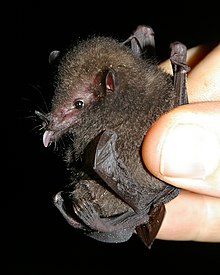
The New World leaf-nosed bats (Phyllostomidae) are bats found from southern North America to South America, specifically from the Southwest United States to northern Argentina. They are ecologically the most varied and diverse family within the order Chiroptera. Most species are insectivorous, but the phyllostomid bats include within their number true predatory species and frugivores. For example, the spectral bat, the largest bat in the Americas, eats vertebrate prey, including small, dove-sized birds. Members of this family have evolved to use food groups such as fruit, nectar, pollen, insects, frogs, other bats, and small vertebrates, and in the case of the vampire bats, even blood.
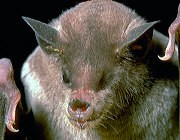
The lesser long-nosed bat is a medium-sized bat found in Central and North America. It is sometimes known as Sanborn's long-nosed bat or the Mexican long-nosed bat, though the latter name is better avoided since it is also used for the entire genus Leptonycteris and for one of the other species in it, the greater long-nosed bat.

The Jamaican, common, or Mexican fruit bat is a frugivorous bat species native to the Neotropics.
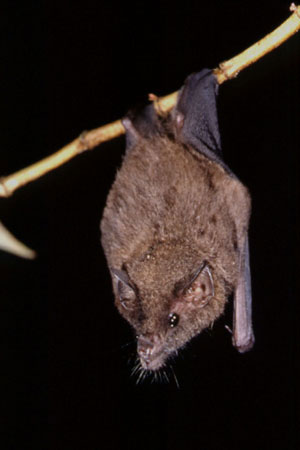
Geoffroy's tailless bat is a species of phyllostomid bat from the American tropics.
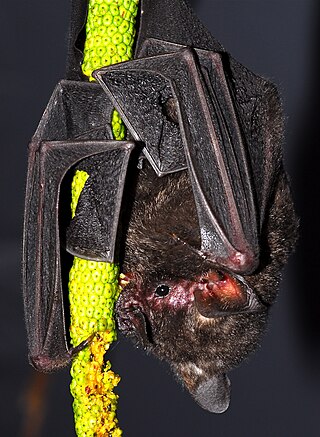
Seba's short-tailed bat is a common and widespread bat species in the family Phyllostomidae. They are found in Central America, the northern parts of South America, and in the Antilles islands.

The dark long-tongued bat is a species of bat from South and Central America. It was formerly considered the only species within the genus Lichonycteris, but is now recognized as one of two species in that genus, along with the pale brown long-nosed bat. It is small species of bat, with adults weighing 6–11 g (0.21–0.39 oz) and having a total length of 46–63 mm (1.8–2.5 in).
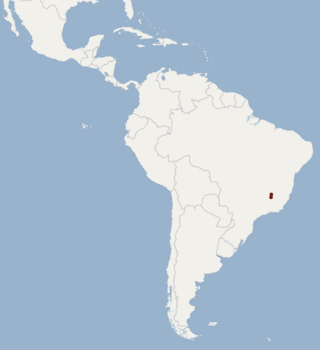
Bokermann's nectar bat is a bat species from South America. It is endemic to Brazil. It feeds on nectar, and is listed as an endangered species.

Dekeyser's nectar bat is a bat species found in Brazil and Bolivia.

The little big-eared bat is a bat species in the order Chiroptera and family Phyllostomidae. It is from South and Central America particularly Colombia, Venezuela, Guyana, French Guiana, Brazil, Peru, Ecuador, Bolivia, Argentina, Paraguay, Suriname and Trinidad. Though its exact population is unknown, it is considered widespread and occurs in protected areas, although deforestation may be a minor threat, it is classified as Least Concern. It is found in multistratal evergreen forests and dry thorn forests and forages near streams and is found hollow trees, logs, caverns, or houses with groups up to twelve. The head and body length measures at 44 millimetres (1.7 in) for males and 45 millimetres (1.8 in) for females. Males usually weigh about 5 grams (0.18 oz) while females weigh 5.7 grams (0.20 oz).

The great stripe-faced bat or stripe-faced vampire bat is a bat species found from southern Mexico to Bolivia and northwestern Brazil, as well as on Trinidad. The great stripe-faced bat is a frugivore. It is one of two species within the genus Vampyrodes the other being Vampyrodes major.

The gray short-tailed bat, or Hahn's short-tailed bat, is a species of bat in the family Phyllostomidae native to Mexico and Central America.

The Mexican long-tongued bat is a species of bat in the family Phyllostomidae. It is the only species within the genus Choeronycteris. The species is found in El Salvador, Guatemala, Honduras, Mexico, and the United States.

Underwood's bonneted bat is a species of bat in the family Molossidae.
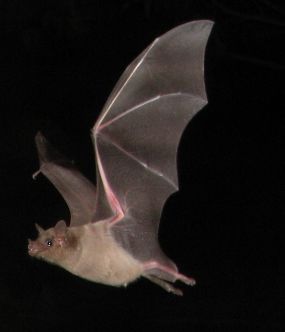
The southern long-nosed bat is a South American species of bat in the family Phyllostomidae.

The orange nectar bat is a species of bat in the family Phyllostomidae. It is found in Colombia, Costa Rica, Ecuador, Nicaragua, Panama, Peru, and Venezuela.
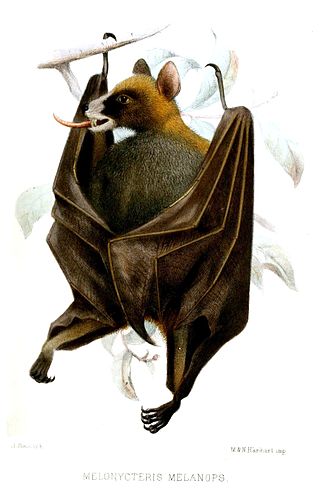
The black-bellied fruit bat is a species of order bat in the family Pteropodidae.

Leach's single leaf bat, also known as Greater Antillean long-tongued bat, is a species of bat in the family Phyllostomidae. It is found in the southern Bahamas and in all the Greater Antilles. It forms large colonies, with up to a few hundred thousand individuals, and feeds on a relatively wide variety of food items including pollen, nectar, fruit and insects.

The banana bat is an endangered species of bat in the family Phyllostomidae. It is also commonly known as the trumpet-nosed bat or the Colima long-nosed bat.

The Cuban flower bat, also called Poey's flower bat, is a species of bat in the family Phyllostomidae. It is found on the Caribbean islands of Cuba and Hispaniola.

Cecil Frank Underwood was a British scientific collector of mammal and bird specimens in Central America.
